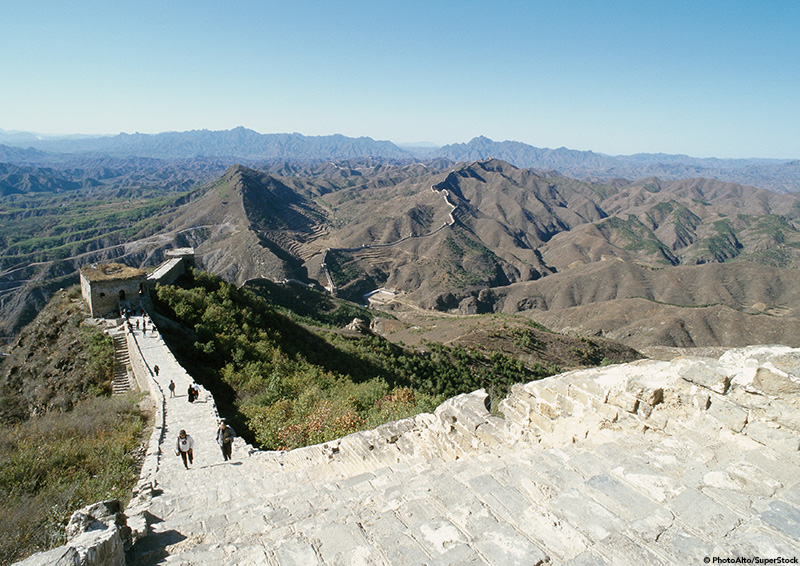The Great Wall of China
Many people think the Great Wall of China is one continuous wall built at one time. This isn’t accurate. The Great Wall of China is a collection of numerous walls built over a span of two thousand years! It stretches across northern China and southern Mongolia. Most sections of the wall are now ruins and many sections are gone. One fourth of the Great Wall is not actually human-made. Sections of wall are connected by natural barriers such as rivers, dikes, and impassable mountain ridges. Nonetheless, the structure is one of the largest construction projects ever attempted. In 1987, the Great Wall of China was designated as a United Nations Educational, Scientific and Cultural Organization (UNESCO) World Heritage site. The Great Wall attracts thousands of visitors each day.
The Warring States Period
The first parts of the wall date back to the seventh through the fourth century BCE. Individual Chinese states built defensive walls to keep out other states and nomadic peoples. For example, the Chu was the first state to build a permanent defensive wall. Other states followed. In total there were seven states which built separate defensive walls. Over time, the Qin became the strongest state.
The Qin Unify China
In the third century BCE, Qin leader Shihuangdi united the seven states into one Chinese empire. He ordered all fortifications between the states removed to reduce friction for internal administration and to improve movement within the new empire. Shihuangdi also connected the separate walls in the north into a single system. However, following Shihuangdi’s death, the Qin dynasty fell, and the wall was abandoned.
From the Han Dynasty to the Present
During the Han dynasty, the Great Wall also became important for the growth of the trade route known as the Silk Road. The Great Wall was repaired and extended when needed. Despite this, the Mongols broke through the Great Wall and took control of China as well as other parts of Asia and Europe between 1206 and 1368 CE. However, once the Ming dynasty defeated the Mongolian rulers, they improved the Great Wall to prevent another invasion. The Ming added watchtowers, platforms, temples, and pagodas. The work that was done in this period is now the best- preserved section of the wall. In 1644, the Qing dynasty replaced the Ming and lasted until 1912. The Qing avoided interfering with the peoples of Mongolia, Tibet, and other nationalities. Because of this, the Great Wall became less important as a defense mechanism. As the original purpose of the wall became less important, its mythology and symbolism grew. In the twentieth century, international interest in the Great Wall popularized it as a national symbol of China.
Design and Construction
The Great Wall is notable for the following construction and design elements.
Passes were strongholds usually located near trade routes. There were fifteen passes where people could enter and exit through a gate. Each pass was made with huge bricks and stones with dirt and crushed stone filler. There were ramps for horses and ladders for soldiers.

Signal towers were used to send military communications and were often located on hilltops. Fires or lanterns were used to send messages at night while smoke signal messages were sent during the day. Sometimes banners or guns were also used to signal.
The walls themselves are about 21.3 feet wide at the base and stand at an average height of 23 to 26 feet. They are made from different materials including earth sandwiched between wooden boards, adobe bricks, a brick and stone mixture, rocks, pilings, planks, and even sticky rice! Modern studies have shown that the innovative sticky rice is responsible for the Great Wall’s impressive endurance.
The construction and operation of the Great Wall were mostly conducted by people convicted of crimes and conscripted soldiers. It is estimated that approximately 400,000 people died while building the wall and many are thought to be buried in its foundation. Grieving family members feared the spirits of their loved ones would be trapped inside forever. A tradition formed in which mourners would travel across the wall with a rooster to guide the spirits out. In fact, the most famous folktale about the wall, the story of lady Mengjiang, dates to the Qin dynasty and deals with this fate. Soon after they married, Mengjiang’s husband was drafted to help build the Great Wall. When she went to bring him winter clothes, she found out he had died. Legend says she wept so much against the wall that it collapsed and revealed her husband’s bones.
